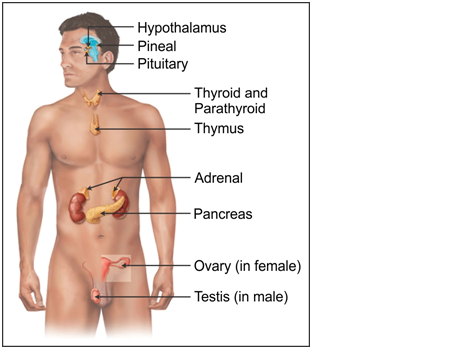Class 11-science NCERT Solutions Biology Chapter 19 - Chemical Coordination And Integration
Chemical Coordination And Integration Exercise 251
Solution 1
- Exocrine glands: Glands which release their secretions into ducts which carry them either on the body surface or to specific body organs are called exocrine glands.
- Endocrine glands: Glands which are ductless and release their secretions into the blood and transported to a distantly located target organ are called endocrine glands.
- Hormone: A non-nutrient chemical which acts as an intercellular messenger and produced in trace amounts is called a hormone.
Solution 2

Solution 3
|
Organs |
Hormones Secreted |
|
(a) Hypothalamus |
|
|
(b) Pituitary |
|
|
(c) Thyroid |
|
|
(d) Parathyroid |
|
|
(e) Adrenal |
|
|
(f) Pancreas |
|
|
(g) Testis |
|
|
(h) Ovary |
|
|
(i) Thymus |
|
|
(j) Atrium |
|
|
(k) Kidney |
|
|
(l) GI Tract |
|
Solution 4
(a) Pituitary gland
(b) Thyroid gland
(c) Adrenal cortex
(d) Testis and ovaries
(e) Pigment cells of the dermis of the skin
Solution 5(a)
Parathyroid hormone (PTH):
- The parathyroid hormone maintains the calcium levels in the body.
- It increases the calcium levels of the blood.
- It stimulates bone resorption which demineralises bones increasing blood calcium levels.
- It also stimulates calcium absorption by renal tubules and from the digested food.
Solution 5(b)
Thyroid hormones:
• Thyroxine/tetraiodothyronine (T4):
- It regulates the basal metabolic rate (BMR).
- It regulates body growth such as ossification of bones and mental development.
- It controls body weight.
- It also controls tissue differentiation and metamorphosis of the tadpole larva into an adult frog.
- It suppresses RBC formation.
• Tri-iodothyronine (T3):
- It increases the body's oxygen and energy consumption.
- It increases the heart rate and force of contraction which increases the cardiac output.
• Calcitonin:
- o It regulates calcium and phosphate levels in the blood.
Solution 5(c)
Thymosin:
- Thymosin stimulates the differentiation of T-lymphocytes and provides cell-mediated immunity.
- It promotes the production of antibodies to provide humoral immunity.
- It also stimulates the rate of cell division in kids and hence promotes growth.
Solution 5(d)
Androgens:
• Testosterone:
- Testosterone helps in the maturation of sperms.
- It stimulates the growth and development of the male reproductive system.
- It stimulates the development of secondary sexual characters such as beard and moustache.
- It produces anabolic effects on protein and carbohydrate metabolism.
• Androsterone:
- It affects the masculinisation of the foetus and child, and maintains or creates masculine traits in adults.
Solution 5(e)
Oestrogen:
- It stimulates the development of ovarian follicles.
- It stimulates the growth and development of female reproductive organs such as the fallopian tube, uterus and vagina.
- It increases the sensitivity of the uterus to oxytocin.
- It decreases the secretion of FSH and increases the secretion of LH.
- It promotes the development of mammary glands.
- It also regulates female sexual behaviour.
Solution 5(f)
Insulin:
- It plays a major role in the regulation of glucose homeostasis.
- It acts on hepatocytes and adipocytes.
- It stimulates the transport of glucose from blood to muscle.
- It promotes the oxidation of glucose and the conversion of glucose to glycogen, i.e. glycogenesis, resulting in hypoglycaemia.
Glucagon:
- It plays a major role in the maintenance of normal blood glucose levels.
- It acts on hepatocytes and stimulates the conversion of glycogen into glucose.
- It also stimulates the process of gluconeogenesis, i.e. the conversion of non-carbohydrate substances such as fats and proteins to glucose.
Solution 6
- Hyperglycemic hormone: Glucagon
Hypoglycemic hormone: Insulin - Hypercalcemic hormone: Parathormone hormone (PTH)
- Gonadotropic hormones: Luteinising hormone (LH) and follicle-stimulating hormone (FSH)
- Progestational hormone: Progesterone
- Blood pressure-lowering hormone: Atrial natriuretic factor (ANF)
- Androgens: Testosterone and androsterone
Oestrogens: β-oestradiol
Solution 7
(a) Diabetes mellitus: Insufficient secretion of insulin
(b) Goitre: Insufficient secretion of thyroxine
(c) Cretinism: Insufficient secretion of thyroxine
Solution 8
- Follicle-stimulating hormone (FSH) is a glycoprotein polypeptide hormone.
- It is insoluble in lipid and hence cannot enter the target cell.
- This hormone binds to the cell surface and activates cellular systems to perform functions.
- Steps in action of FSH:
- A molecule of FSH binds on the receptor protein present on the cell surface and forms the hormone–receptor complex.
- Formation of hormone–receptor complex activates the enzyme adenyl cyclase.
- Adenyl cyclase converts ATP into cyclic AMP (cAMP) as a second messenger.
- cAMP activates the follicular cells of membrane granulose to secrete oestrogens.
Solution 9
|
Column I |
Column II |
|
(a) T4 |
(ii) Thyroid |
|
(b) PTH |
(iv) Parathyroid |
|
(c) GnRH |
(i) Hypothalamus |
|
(d) LH |
(iii) Pituitary |

